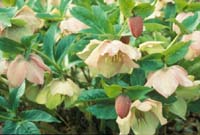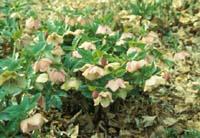Flowers in the Snow
Flowers in the Snow


Hellebores bloom during the 40 days between Ash Wednesday and Easter. Photos by Mary Witt
Given recent weather patterns, it may be difficult for Kentuckians to believe they could see bright blooming flowers in just a few weeks.
“Few plants draw as much attention in the landscape as those that bloom early,” said Rick Durham, Extension specialist in consumer horticulture for the University of Kentucky College of Agriculture. “The Hellebore, or Lenten Rose, is one of the earliest perennials to bloom.”
Durham said the flower’s name comes from the fact that flowering usually begins during Lent, the 40-day period prior to Easter, and often continues until June.
“Don’t be fooled by the common name, however,” Durham continued. “The Latin name Helleborusliterally means food that injures, referring to the poisonous nature of the roots.”
Actually, the entire plant is poisonous from the leaves to the roots and can cause skin irritation for many people, which is why Durham recommends wearing gloves if gardeners experience skin irritation when working with Hellebores.
There are 15 species of Hellebores, all native to Europe. When the plants are not in bloom, they still provide lush ground cover for the landscape.
Durham said Hellebores are slow growers at first, but are fairly easy to grow once they are established. They do best under partial to full shade in well-drained soils.
The attractive evergreen foliage adds texture to the landscape and grows to about 18 inches. The plant does not tolerate heat, so it should be planted in cool sites, such as under deciduous trees and shrubs. Plants occasionally can be divided to produce new plants, or gardeners may transplant any seedlings that germinate near established plants.
Although the flower’s common name is Lenten Rose, the blossoms don’t look like traditional roses; they are more pendulous and saucer-shaped since they are more akin to the buttercup family of flowers. They come in shades of pink, cream to purple, and green.
“To best appreciate the flowers, cut a few and float them on water in a shallow vase or bowl,” Durham said. “They are sure to draw lots of attention there as well.”